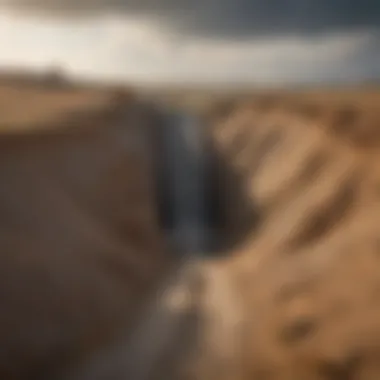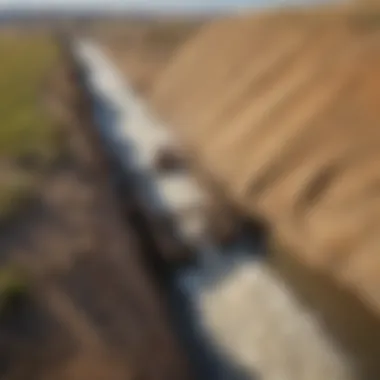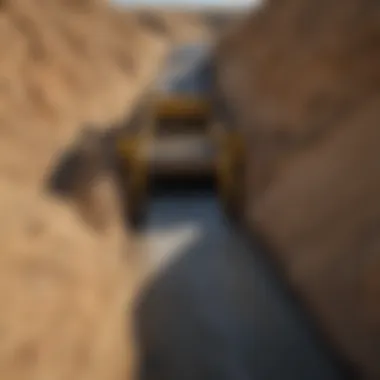Exploring Powder River Chutes: A Comprehensive Guide


Intro
Powder River chutes are a critical component in modern livestock management. Their design and functionality play a significant role in enhancing the efficiency and safety of animal handling. This guide dives into various aspects of Powder River chutes, focusing on their importance for farmers and ranchers.
Topic Overview
Definition of Key Terms
A chute is a structured pathway that facilitates the movement of livestock from one area to another, often for veterinary care, loading, or sorting. The Powder River chute is a specific brand known for its durability and innovative design in the livestock handling sector.
Relevance in Agriculture, Horticulture, and Agronomy
In agriculture, efficient livestock handling is essential. Using Powder River chutes enables easier movement and management of cattle. This directly influences productivity and reduces stress on animals. Animal welfare is becoming increasingly important, and well-designed chutes contribute to better handling practices.
Current Trends and Innovations
Recent Advancements in the Field
Innovation in livestock handling is ongoing. New materials and designs that reduce wear and enhance safety are being introduced. Technologies that integrate automated systems for monitoring animal behavior during handling are also emerging.
Emerging Technologies and Practices
Smart technology is gaining traction in animal management. Features like weight sensors and remote monitoring applications are helping ranchers make informed decisions. These technologies contribute to better health management, optimizing ranch operations.
Practical Applications
Step-by-Step Guides or How-Tos
- Assess Your Needs: Determine what you need based on your livestock operation size and type.
- Choose the Right Chute: Consider the specific features of Powder River chutes and how they fit your requirements.
- Installation: Follow the manufacturer’s instructions for safe and efficient setup. Ensure the chute is level and securely anchored.
- Training: Familiarize yourself and your staff with the chute operation. This ensures safety during handling.
Tips and Best Practices for Implementation
- Regularly inspect the chute for wear and tear.
- Keep the area around the chute clean to avoid accidents.
- Train staff on animal behavior to minimize stress during handling.
“Efficient livestock handling reduces stress for both animals and operators, contributing to better health outcomes.”
Understanding Powder River Chutes
Understanding Powder River chutes is vital for anyone involved in livestock management. These chutes play an essential role in streamlining processing tasks and ensuring the safety of both animals and handlers. When farmers and ranchers recognize the key features and benefits of Powder River chutes, they can improve their operational efficiency and enhance overall animal welfare. This section will discuss the historical context, design principles, and engineering aspects that contribute to the effectiveness of these chutes.
Historical Background
Powder River chutes have a rich history in the agricultural industry. Developed to address the challenges of managing livestock safely and efficiently, their evolution mirrors the advancements in farming technology. Initially, livestock handling relied on manual methods, which posed various risks to both animals and handlers. The introduction of well-designed chutes marked a significant turning point, enabling operators to process animals with greater ease. Over the decades, these systems have adapted to meet the changing demands of modern agriculture, ensuring that they remain relevant and effective in contemporary livestock management.
Design and Engineering Principles
The design and engineering of Powder River chutes are pivotal to their functionality. Multiple factors come into play to ensure these structures provide a safe and effective means of handling livestock.
Materials Used
The materials used in the construction of Powder River chutes significantly impact their durability and performance. Generally, the chutes are made from high-grade steel which offers strength and longevity. This choice is beneficial because it resists wear and tear associated with frequent use. Additionally, the heavy-duty features of the steel ensure that the equipment can withstand the stress caused by large animals. However, understanding the balance between weight and structural support is crucial in optimizing their use.
Structural Integrity
The structural integrity of Powder River chutes is another critical feature that cannot be overlooked. This aspect ensures that the chute can support the weight and movement of livestock without compromising safety. The design incorporates welds and reinforcements strategically placed to enhance strength while maintaining a lightweight frame. The result is a robust structure that minimizes the risk of collapse during loading or unloading processes. However, maintenance is necessary to address any wear that may occur over time.
Aesthetic Considerations
While functionality is the main focus, aesthetic considerations in the design of Powder River chutes play a role too. Many modern chutes boast designs that blend seamlessly into agricultural environments. A well-designed chute can enhance the overall appearance of a farming operation. Additionally, user-friendly designs make the operation easier for ranchers and workers. Yet, aesthetic appeal should not overshadow the primary goal: efficient and safe livestock handling.


"The right balance of durability, safety, and aesthetic appeal is crucial for optimizing livestock handling operations."
In summary, understanding Powder River chutes requires a close look at their historical development, design intricacies, and the critical materials that go into their construction. The insights provided here lay the groundwork for comprehending their overall importance in livestock management.
Functionality of Powder River Chutes
The functionality of Powder River chutes plays a crucial role in modern livestock management. Their design combines efficiency, safety, and practicality, making them essential tools for farmers and ranchers. Understanding these systems helps one comprehend how to maximize their benefits in real-world applications.
Core Features
Manual vs. Automatic Operations
The choice between manual and automatic operations is significant in the functionality of Powder River chutes. Manual operations allow for direct human control, which some operators prefer during lower-volume tasks. This aspect creates a sense of familiarity and adaptability, as ranchers can make adjustments to the handling process in real-time. However, automatic operations can greatly enhance efficiency during high-volume activities. They minimize labor efforts and reduce the potential for human error, making them a popular option among larger operations. Ultimately, the decision between these two methods depends on the specific needs of the operation.
Customizable Options
Customizable options provide an important advantage to users of Powder River chutes. The ability to tailor chutes to accommodate different types and sizes of livestock ensures that every handling situation is optimized for both animal welfare and operational efficiency. Customization can range from adjustable side panels to removable rear gates. Farmers appreciate this flexibility, as it allows them to adapt their equipment based on specific task requirements. However, customization may increase upfront costs and complicate maintenance.
Safety Mechanisms
Safety mechanisms are critical in enhancing the functionality of Powder River chutes. Features like spring-loaded latches and secure locks prevent accidental openings and ensure that animals remain safely contained. These mechanisms contribute not only to the safety of the livestock but also to the workers handling them. Effective safety measures can minimize the risks associated with livestock handling, enhancing overall productivity and reducing potential injuries.
How They Work
Understanding how Powder River chutes work is essential for effective livestock management. Their operation revolves around efficient loading and unloading, proper animal handling procedures, and overall operational efficiency.
Loading and Unloading Protocols
The protocols for loading and unloading livestock are vital to the effective use of Powder River chutes. A well-designed system facilitates safe animal entry and exit without causing stress. Protocols often include the elimination of sharp turns and the inclusion of smooth ramps. Implementing these protocols optimizes the handling process, allowing operators to work more efficiently and reduce time spent on each task.
Animal Handling Procedures
Animal handling procedures incorporate various techniques to ensure the welfare of livestock during transit. A good procedure promotes calmness among animals, which reduces the likelihood of injury. Proper handling procedures include using low-stress techniques and ensuring that powering down activities occur gradually. This method not only reassures the animals but also ensures that workers maintain a safe environment while managing them.
Operational Efficiency
Operational efficiency is a comprehensive measure of how well Powder River chutes perform their intended function. Various factors influence this efficiency, including design elements, materials, and user training. Effective operational practices lead to quicker processing times, lower labor costs, and reduced stress on livestock. Enhancing operational efficiency means investing in quality equipment and educating staff on best practices. This improved efficiency ultimately leads to a more productive ranching operation.
Benefits of Using Powder River Chutes
The Powder River chutes represent a significant advancement in livestock management. They offer a range of benefits that enhance the handling of cattle and other livestock. Understanding these advantages is crucial for farmers and ranchers as they seek to improve operational efficiency and animal welfare. The following sections will delve into specific benefits associated with using Powder River chutes, highlighting their impact on livestock management.
Enhanced Livestock Handling
One key aspect of Powder River chutes is their ability to promote better livestock handling. Designed with the comfort of animals in mind, these chutes minimize stress during routine procedures such as vaccinations, tagging, and examinations.
- Design Features: The chutes often feature smooth surfaces and rounded edges, reducing the risk of injury.
- Directional Control: The ability to guide animals with ease ensures they do not feel cornered or panicked.
The careful design translates to improved cooperation from livestock, making routines more effective. Handling livestock with less stress is beneficial for both the animals and the operator.
Safety for Animals and Operators
Safety stands out as a fundamental concern in livestock management. Powder River chutes address this through structural design and safety features.
- Safety Mechanisms: Many models include safety latches and barriers that prevent unintentional exits, keeping both animals and operators secure.
- Operator Positioning: The layout allows proper spacing, so operators can handle animals without the risk of being cornered or injured.
By prioritizing safety, these chutes help mitigate accidents and injuries, promoting a healthier environment for both livestock and workers.
Efficiency in Operations
Operational efficiency is essential for any productive farm operation. Powder River chutes enhance this in several ways.


- Time-Saving Features: Automatic operation options streamline commonly performed tasks, reducing the time needed for each process.
- Customizable Configurations: The ability to tailor features according to specific livestock needs aids in optimizing workflow.
Improving efficiency means that tasks can be completed more rapidly, freeing up time for other essential activities on the farm. This structure translates into cost savings and better resource management.
"Investing in Powder River chutes is not just about better handling; it's about reshaping how livestock operations function in a more humane and efficient way."
Considerations for Implementation
When it comes to investing in Powder River chutes, several considerations are crucial for implementation. These factors can greatly influence the effectiveness and efficiency of livestock handling. Understanding these considerations helps farmers make informed decisions that enhance their operations.
Choosing the Right Model
Size and Capacity Requirements
Size and capacity are key elements when selecting a chute model. The appropriate size ensures that the chute can accommodate different livestock without causing stress. It is essential to assess the dimensions of the animals being handled and how many will be processed at any given time. A chute that is too small might lead to overcrowding, resulting in safety hazards and discomfort for the animals. Moreover, selecting a model with adjustable features can provide versatility for future expansions or changes in livestock types.
Specific Features for Different Livestock
Different species of livestock have unique handling needs. For example, cattle and sheep require different designs for optimal efficiency during processing. A chute tailored for specific species enhances workflow and minimizes handling stress. Customizable features, like gates and panels, allow for adjustments based on animal behavior and size. This factor can also significantly influence productivity, allowing for smoother operations when managing various livestock types.
Budget Constraints
Understanding budget constraints is fundamental in the decision-making process. While higher-end models may offer advanced features and better durability, they may not fit every farmer's financial situation. It is crucial to evaluate the long-term value versus initial costs. Budget-friendly models may lack some conveniences but can still perform effectively. Finding a balance between cost and functional requirements is key. These constraints often influence the choice, shaping the overall strategy for livestock management.
Installation Guidelines
Location Selection
Selecting the proper location for installation is vital for maximizing the efficiency of Powder River chutes. The area must provide adequate space for both the chute and the surrounding operational workflow. This avoids bottleneck situations during loading and unloading processes. Additionally, ensuring easy access to water and feed is beneficial for animal welfare. A well-thought-out location can reduce the stress on livestock, which is essential in any handling procedure.
Structural Requirements
Considering the structural requirements is essential for safe and effective installation. The chosen location must have sturdy foundations to support the chute. Weight distribution and stability are crucial, particularly when handling larger animals. A robust design not only ensures safety but also extends the lifespan of the equipment. Understanding soil conditions and weather factors also contributes to making informed decisions about the installation process.
Maintenance Considerations
Regular maintenance is a vital aspect of any livestock handling system. Establishing a maintenance plan helps in prolonging the chute's lifespan while ensuring continuous functionality. Key areas of focus include inspecting pivot points, checking for wear and tear, and ensuring all safety features are operational. A well-maintained chute reduces the risk of accidents and enhances livestock handling efficiency. It is wise to set aside resources for both routine checks and potential repairs.
"Implementing Powder River chutes is more than just setting up equipment. It’s about integrating a system that enhances overall farm efficiency and animal welfare."
Comparative Analysis with Other Chute Systems
In the realm of livestock management, having the right chute system is fundamental. This section examines how Powder River chutes compare to other systems available on the market. Understanding these distinctions is vital for farmers and ranchers aiming to enhance their operations. The analysis highlights the advantages of Powder River chutes and illustrates the relevant aspects that set them apart.
Advantages over Traditional Chutes
Powder River chutes present various advantages when compared to traditional chutes. These benefits can significantly impact efficiency and safety within livestock handling operations. One of the key advantages is the adaptability of Powder River chutes. Unlike traditional options, which may be rigid in their design, Powder River chutes offer customization to fit specific operational needs.
- Increased Safety: The design focuses on animal welfare, reducing stress during handling.
- Durability: Made from high-quality materials, these chutes withstand harsh environments better than older models.
- User-Friendly Design: Operators find them easier to use, which reduces potential accidents.
As a result, ranchers find that investing in Powder River products yields better long-term returns compared to traditional chutes.
Technological Innovations
The advancement of technology plays a crucial role in today's agricultural practices. Powder River chutes leverage these innovations effectively, making them a leading choice among modern farmers.
Integration with Livestock Tracking Systems
One significant enhancement in modern chutes is the integration with livestock tracking systems. This capability allows ranchers to monitor their livestock's health and location in real time. The key characteristic of this integration is its data collection functionality. This characteristic makes it a beneficial choice for increasing security and effective herd management.


- Unique feature: This will help in making informed decisions quickly.
- Advantages: Owners can track vaccinations, movements, and breeding cycles more efficiently.
- Disadvantages: Initial setup costs can be high, but the long-term benefits often outweigh these.
Using tracking systems can be a transformative approach for ranchers looking to enhance their operational oversight.
Use of Automation and Sensors
Automation and sensor technology represent another cornerstone of innovation in Powder River chutes. This technology contributes directly to streamlining processes and increasing productivity. The primary aspect is that these systems reduce manual labor, making operations more efficient and less prone to human error.
- Key characteristic: The ability to remotely control various chute functions can be a game changer.
- Unique feature: Sensors can detect animal behavior changes, which aids in better handling.
- Advantages: It minimizes stress on animals and allows for quicker responses to any issues.
- Disadvantages: Like integration, automation requires significant investment initially but pays off in the long term.
Overall, these technological advancements not only address current needs but also pave the way for future innovations in livestock management. The comparative analysis reinforces why Powder River chutes stand out, making them a preferred choice for modern agricultural practices.
Case Studies and Testimonials
Exploring the practical applications of Powder River chutes through case studies and testimonials is crucial in understanding their effectiveness and reliability in the field. This section showcases real-world experiences that illustrate the impact of these chutes on livestock management. These insights provide valuable knowledge for farmers and ranchers considering the implementation of this equipment. Through specific cases, one can see not only the benefits but also the challenges that may arise, enhancing our overall comprehension of Powder River chutes.
Successful Implementation in Commercial Farms
In commercial farming, efficient livestock handling is vital. Here are several case studies that highlight how Powder River chutes have been successfully integrated into operations.
- Case Study of Green Valley Farms: At Green Valley Farms, the implementation of Powder River chutes resulted in a 30% reduction in cattle handling time. This farm switched from a traditional chute system to an automatic Powder River model. The transition minimized stress for animals and sped up the workflow, ultimately leading to more efficient operations.
- Doe Ranches: Doe Ranches emphasizes safety and efficiency. The ranch integrated Powder River chutes to manage its cattle more effectively during vaccination and health checks. The result was a notable decrease in animal injuries. The ranch reported a significant increase in the productivity of their workforce due to reduced handling time.
These examples affirm the ability of Powder River chutes to adapt to different farming environments, providing substantial improvements to livestock handling practices.
Rancher Experiences
Ranchers have shared their experiences regarding Powder River chutes, which reflect real-life outcomes and the versatility of these systems.
“Switching to Powder River chutes was a game changer for us. Our cows remain calmer, and my team feels safer during handling.”
This insight emphasizes the benefits of safety and animal welfare connected with using these chutes.
Some ranchers highlight the significance of design in their testimonials. They noted how the materials and engineering principles contribute to the structural integrity of the chutes, allowing for reliable performance in challenging weather conditions. Ranchers appreciate features such as customize options that allow tailoring the chutes to their specific needs.
Overall, positive feedback from ranchers fosters confidence in adopting Powder River chutes as a long-term solution for livestock management. Their stories illustrate not just successes but also solutions to common challenges faced during livestock operations. Such anecdotes can guide potential users in making informed decisions.
Future Trends in Livestock Handling Equipment
The livestock industry is undergoing significant transformation driven by the need for enhanced efficiency and sustainability. This section emphasizes the emerging trends in livestock handling equipment, with a particular focus on Powder River chutes. These trends are vital for farmers and ranchers to understand, as they have direct implications on operation performance, safety, and animal welfare.
Sustainability Initiatives
Sustainability has become a central theme in modern agriculture. Farmers and ranchers are increasingly adopting practices that minimize environmental impact while maximizing productivity. For Powder River chutes and other livestock handling equipment, several sustainability initiatives are gaining traction:
- Eco-friendly Materials: Manufacturers are now using recyclable and sustainable materials in the production of chutes, reducing waste.
- Energy Efficiency: Equipment now often features energy-efficient designs. This reduces operational costs while promoting responsible energy usage.
- Water Conservation: New designs include features that minimize water usage during cleaning and maintenance, addressing the growing concern over water resources.
These sustainability initiatives not only contribute to environmental preservation but also enhance the reputation of operations. Consumers are more likely to support farms that prioritize sustainable practices.
Emerging Technologies
The integration of technology in livestock handling is evolving. Emerging technologies in this field focus on improving operational efficiency, enhancing safety, and providing better tracking and health monitoring of animals. Some key advancements include:
- Automation: Automated systems for loading and unloading increase efficiency, allowing operators to manage livestock with minimal physical effort.
- Sensor Technology: Sensors that monitor animal behavior and health can provide real-time data. This can help in making informed decisions promptly.
- Data Analytics: Advanced analytics tools are being integrated into equipment, tracking performance metrics. This allows for continuous improvement and optimization of handling practices.
"Integrating technology in livestock facilities improves not just productivity but also animal welfare, as better handling leads to reduced stress on the animals."
As farms continue to adapt to these technologies, the landscape of livestock handling will see a marked improvement in both output and overall animal care. The investment in these future trends is not merely an upgrade; it is a necessity for those looking to remain competitive in a rapidly evolving agricultural sector.
The End
The conclusion serves as a critical reflection on the insights presented throughout this article. It encapsulates the importance of utilizing Powder River chutes in modern livestock management. With various factors to consider, such as safety, efficiency, and animal welfare, these chutes significantly influence the overall operational effectiveness on farms.
Summation of Key Points
In revisiting the core elements discussed in this article, it is clear that
- Powder River chutes combine innovative design with practical functionality.
- They enhance the safety of both animals and operators during handling procedures.
- The flexibility and customization options cater to diverse needs in livestock management.
- Incorporating these chutes can lead to notable improvements in operational efficiency.
Overall, the information emphasizes how Powder River chutes embody the advancements in agricultural tools, contributing to better practices within livestock handling.



